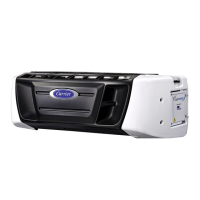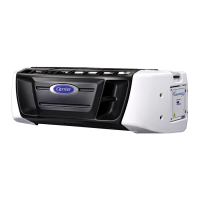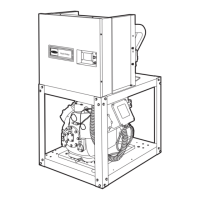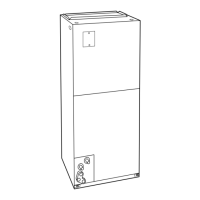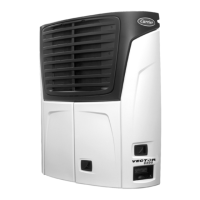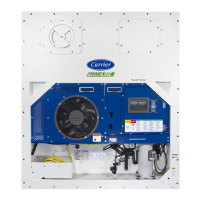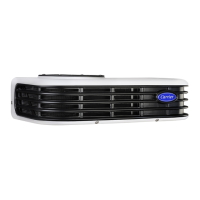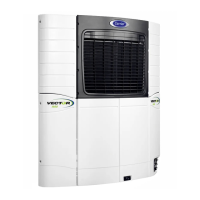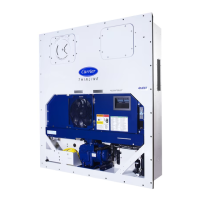3-5
T -309
mode and the heaters will be energized . The unit will
transition back to the perishable idle mode when the
temperature rises to 0.2_C (0.4_F) below the set point
and the heaters will de-energize
3.3.7 Perishable Mode -- Economy
Theeconomymode is an extensionoftheconventional
mode. The mode is activated when the setting of
function code Cd34 is “ON”. Economy mode is
provided for power saving purposes. Economy mode
could be utilized in the transportation of temperature
tolerant cargo or non-respiration items which do not
require high airflow for removing respiration heat.
Thereis noactivedisplayindicatorthat economymode
has been activated. To check for economy mode,
perform a manual display of code Cd34.
In order to achieve economy m ode, a perishable set
point must be selected prior to activation. When
economy mode is active, the evaporator fans will be
controlled as follows:
At the start of each cooling or heating cycle, the
evaporator fans will be run in high s peed for t hree
minutes. They will then be switched to low speed any
time the supply air temperature is within ¦ 0.25_C
(0.45_F )ofthesetpointandthereturnairtemperatureis
less than or equal to the supply air temperature + 3_C
(5.4_F). Thefans will continue to run in low speed for
onehour.Attheendofthehour,theevaporatorfanswill
switchbacktohighspeedandthecyclewillberepeated.
Ifbulb modeis active,theeconomyfan activitywill be
overwritten.
3.3.8 Perishable Mode -- Dehumidification
The dehumidification mode is provided to reduce the
humidity levels inside the container. The mode is
activated when a humidity value is set at at function
codeCd33. ThedisplaymoduleSUPPLYled will flash
ON and OFF every second to indicate that the
dehumidification mode is active. Once the Mode is
active and the following conditions are satisfied, the
controller will activate the heat relay to begin
dehumidification.
1. The humidity sensor reading is above the set point.
2. The unit is in the perishable steady state mode and
supply airtemperatureis less than0. 25_C aboveset
point.
3. Theheaterdebouncetimer(threeminutes)hastimed
out.
4. Heater termination thermostat (HTT) is closed.
Ifthe aboveconditions aretruetheevaporatorfanswill
switch from high to low speed operation. The
evaporatorfanspeedwillswitcheveryhourthereafteras
long as all conditions are met (see Bulb Mode section
for different evaporator fan speed options). If any
condition except for item (1) becomes false OR if the
relative humidity sensed is 2% below the
dehumidification set point, the high speed evaporator
fans will be energized.
In the dehumidification mode power is applied to t he
defrost and drain pan heaters. This added heat load
causes the controller to open the suction modulating
valve to match the increased heat load while still
holding the supply air temperaturevery closeto the set
point.
Opening the modulating valve reduces the temperature
oftheevaporatorcoilsurface,whichincreasestherateat
which water is condensed from the passing air.
Removing water from the air reduces the relative
humidity. When the relative humidity sensed is 2%
belowthesetpoint,thecontrollerde-energizestheheat
relay. The controller will continue to cycle heating to
maintainrelativehumiditybelowtheselectedsetpoint.
If the mode is terminated by a condition other than the
humidity sensor , e.g., an out-of-range or compressor
shutdown condition, the heat relay is de-energized
immediately.
Two timers areactivated in the dehumidification mode
toprevent rapidcycling andconsequentcontactorwear.
They are:
1. Heater debounce timer (three minutes).
2. Out-of-range timer (five minutes).
The heater debounce timer is started whenever the
heater contactor status is changed. The heat contactor
remains energized (or de-energized) for at least three
minutes even if the set point criteria are satisfied.
The out-of-range timer is started to maintain heater
operationduringatemporaryout-of-rangecondition. If
the supply air temperature remains outside of the user
selectedin-rangesettingformorethanfiveminutes,the
heaters will be de-energized to allow the system to
recover. The out-of-range timer starts as soon as the
temperature exceeds thein-range tolerance value set by
function code Cd30.
3.3.9 Perishable, Dehumidification -- Bulb Mode
Bulb mode is an extension of the dehumidification
modewhichallowschangestotheevaporatorfanspeed
and/or defrost termination set points.
Bulb mode is active when configuration code Cd35 is
set to “Bulb”. Oncethe bulb mode isactivated, theuser
maythenchangethedehumidificationmodeevaporator
fan operation from the default (speed alternates from
low to high each hour) to constant low or constant high
speed. This is done by toggling function code Cd36
fromitsdefaultof“alt”to“Lo”or“Hi”asdesired.Iflow
speedevaporatorfanoperationisselected,thisgivesthe
user the additional capability of selecting
dehumidification setpoints from60 to 95% (insteadof
the normal 65 to 95%).
In addition, if bulb mode is active,function code Cd37
may be set to override the previous defrost termination
thermostat settings. (Refer to paragraph 4. 9.5.) The
temperatureatwhichthedefrostterminationthermostat
will be considered “open” may be changed [in 0.1_C
(0.2_F) increments] to any value between 25.6_C
(78_F)and4_C(39.2_F ).Thetemperatureatwhichthe
defrost termination thermostat is considered closed for
interval timer start or demand defrost is 10_Cfor
“open” values from 25.6_C(78_ F) down to a 10_C
setting. For “open” values lower t han 10_C, the
“closed” values will decrease to the same value as the
“open” setting. Bulb mode is terminated when:
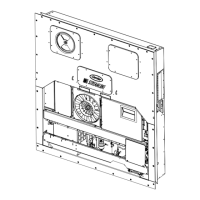
